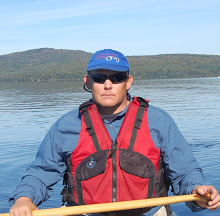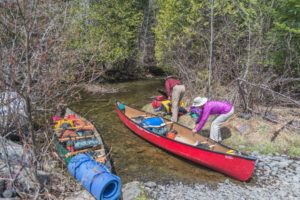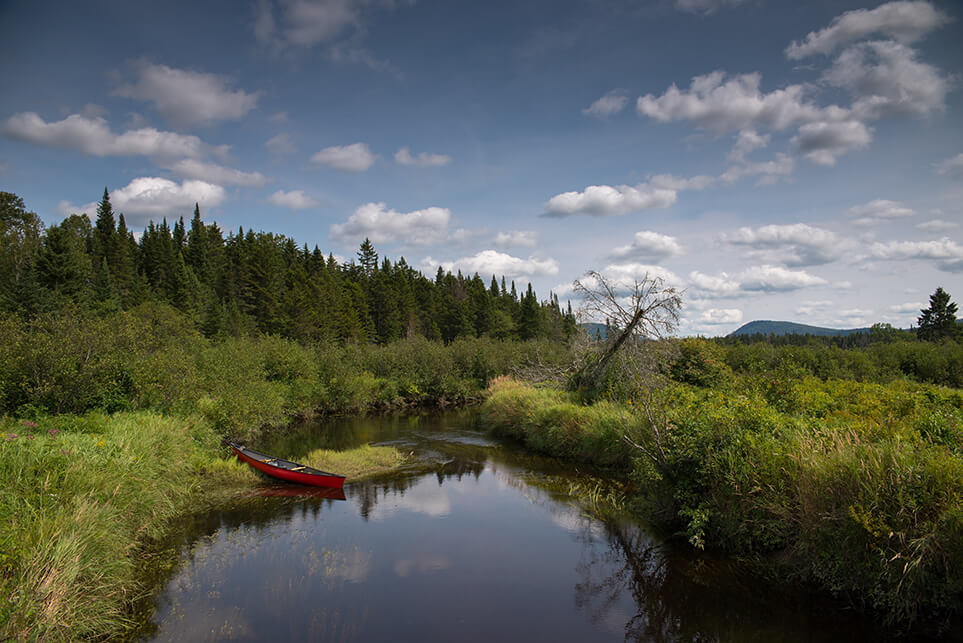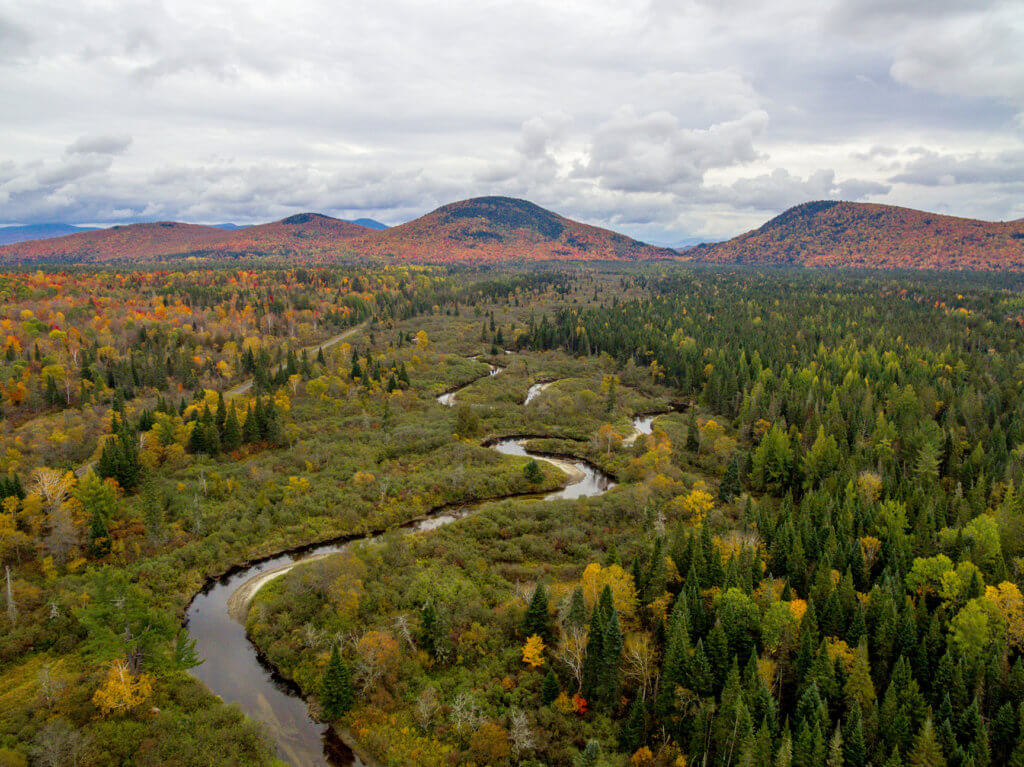As the Northern Forest Canoe Trail celebrates its 20th anniversary, we’re catching up with longtime trail supporters to learn how the NFCT has shaped their lives and why it matters.
Chris Gill worked as a professional rock climbing guide for over a decade, traveling around the country for two and three month stints, climbing and teaching. In 1990, he got a job working for movies — including The River Wild — where he put his climbing skills to good use, hanging and attaching props on film, commercial, and theater sets.
After the birth of his first child, in 2000, Chris came back east to work for the family business — a move that influenced his next 20 years of outdoor recreation. Read on for our interview with Chris Gill.

Chris Morris: Once you had kids, that’s when you started getting into paddling?
Chris Gill: When we had our son, we started looking for things to do as a family — I had canoed at various points in my life, like summer camp for example. We would borrow my brother’s canoe and go on family trips. I have a lot of outdoor experience, so at the time it didn’t take much for me to jump from backpacking to canoe camping.
CM: Tell me about your history and connection with the NFCT.
CG: In 2007, we discovered the trail. We decided it was a great goal as a family and for myself. My first trip was on the Clyde River, starting at Island Pond and then down to Salem Pond overnight.
CM: What were the family trips like?
CG: The family trips were day trips because the kids had a limited attention span. We started paddling as a family around 2005. We would take a family vacation and stay at Island Pond at the state park, paddled around the lake. Or, we would just do day trips to places in western Massachusetts. When the kids got a little older, and had more experience with the NFCT, we started to do some longer trips.
One of our first trips was in the Adirondacks, on Upper Saranac Lake and in the St. Regis Canoe Area. It was my wife, the two kids and my brother — and having the extra adult made a big difference on the carries. That was a great trip — it was in the fall, and it was beautiful.
Our first real NFCT trip was Long Lake to Axton Landing — that was a fun trip. We caught some horrendous weather in Long Lake — we did the Raquette Falls carry in a big thunderstorm, but the kids thought it was exciting.
In 2010, we did the Allagash for my son’s 10th birthday. We started in Rockwood and paddled Moosehead Lake, following along where Thoreau had paddled. We did the Mud Pond carry with both kids, in the rain.
CM: It seems like you’ve had some bad luck with carries and weather.
CG: Oh no, they were fine — obviously, would have preferred better weather. We don’t complain about the carries. The kids had a great time on the Raquette Falls carry despite the thunderstorm.
One thing we always did with the kids, when they were young, was the camping fairy, which would come along with us. Every night, the camping fairy would leave something for the kids to play with — a rope to tie knots in, a magnifying glass, a jar to carry bugs in. That was always a fun thing to do.
CM: How did those experiences shape your kids’ lives?
CG: They’re both really comfortable outdoors. Neither has pursued long trips like what we did growing up. My son likes to hike. I think at some point they might swing back to it — they’ve had the exposure and are pretty knowledgeable. You sort of let them go their own way at this point in their lives.

CM: Do you have any memories or experiences on the NFCT that stand out in particular?
CG: When we did the Long Lake to Axton Landing trip, doing that Raquette Falls carry during the thunderstorm. We were setting up camp after the storm passed, and Gary Valentine the caretaker was walking up the trail to find cell service. He met up with us, we talked for a while, he talked to the kids — it was great. The next morning I got up early to carry the boats and saw Gary again. There was a big group of college kids — an outing club, I think — and they were having a really tough time getting organized. Just couldn’t get it together. Meanwhile, my kids came down the trail with their packs and everything, all set to go. Gary was laughing at the whole scene — my kids all ready to roll, and these college kids struggling.
I also remember counting moose with my son in the Allagash, chasing rabbits at the campsites — paddling down the east branch of the Penobscot when a swimming red squirrel tried to get in the canoe.
Maybe a little more harrowing was our adventure during Hurricane Irene in 2011. We were paddling up the moose, did a five-mile portage over to Fish Pond and Spencer Lake. Our plan was to spend the night at the Grand Falls hut. We were doing the portage and were about 3/4ths of a mile from the end and wheeling along the road. Some people in a pickup truck stopped and asked if we wanted a ride, and we responded that we were fine — then as they left, they said, “Just be careful of the hurricane.” That was the first we’d heard of it. They told us it was coming in two days.
We put in at Spencer Lake — the most beautiful lake on the trail I think — and then spent the night. We tried to paddle down Spencer Stream but the water was so low we had to drag the canoe. We got to the confluence of the Dead River a day ahead, and realized our car wasn’t there yet. So we spent the night there, and when we got up, I could see the water level rising. We went to the hut and saw the caretaker, told them we had reservations, but they had closed — but, they didn’t turn us away. We told them we were waiting for our car, and then found out that it had been left for us a few days earlier.
We were fine — never in any danger — but it was a pretty exciting experience. People had been trying to call, email, text — but we were out of cell range. The kids thought it was a big adventure.
Three or four days later, I looked at the river gauge, and Spencer Stream had risen 6 feet.

CM: We first connected not long after I came on board at NFCT — through your photography.
CG: I really enjoy that. My other hobby is as an observer of nature. Birding, native plants of the northeast, wild flowers — I love to photograph it. When I started doing more paddling, I got interested in taking photos of the canoe trips, which was a fun thing to do. Later, when drones came out, my dad got one — it was great, so I got one.
The first place I went with my drone, during peak foliage season, was the Nulhegan, where I’m the trail maintainer. It’s just so fantastic — it gives you a great view and perspective of the trail. I think it’s really appealing to see the waters from that angle — and if it’s done ethically and responsibly, it’s a really beneficial tool. You can sort of see what you’re getting into. A photographer is usually trying to tell a story with their photos — I think the drone shots add to that story.

CM: From a bigger perspective, why is the Northern Forest Canoe Trail important to you?
CG: It offers accessible outdoor recreation to a lot of people. It’s low impact recreation that you can do pretty easily. And the historical perspective is important to keep alive, too — it’s good to see wildlife and nature as it was 200 years ago, and in a lot of places it is like that.
It also gets people back to nature — it’s important for people to reconnect with that. It’s a valuable resource for people. I’ve made a lot of good friends along the trail, lifetime friends. I met my canoe partner, Russ Ford, at the 10th anniversary trail event. I think it’s good for the whole Northern Forest region to have this connective system. Sometimes the popularity saddens me some, but that’s OK.
CM: What do you think the future holds for the NFCT?
CG: Going forward, promoting paddling, promoting the trail — I think that’s good and the direction it should go in. I like that you’re promoting more family trips, day trips and side trips. I’d also like to see more gentle environmentalism — supporting anything that helps the environment on the trail, which NFCT has done with invasive species, promoting “leave no trace.” Offering advice along those lines is good.
In addition to completing the entire trail in sections over ten years, Chris volunteers as a Waterway Steward, maintaining the Nulhegan River section. He has shared many of his beautiful photos with our organization and community, he leads community paddles and even took a turn on the Board of Directors. Chris, and many others like him, are what makes the Northern Forest Canoe Trail paddlers’ community a welcoming and helpful asset to our organization.